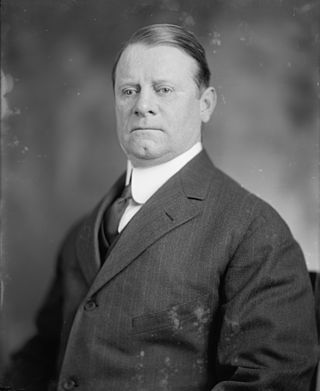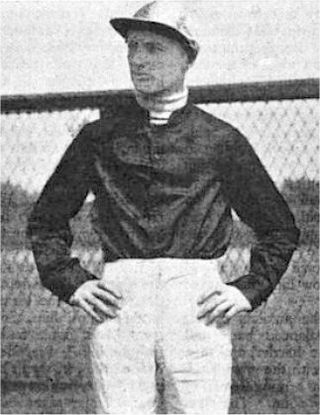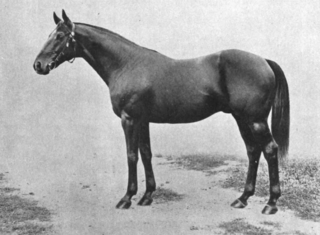Related Research Articles

Sir Barton was a champion American Thoroughbred racehorse who is the first winner of the American Triple Crown.
The Stuyvesant Handicap was an American Thoroughbred horse race held annually in the fall of the year at Aqueduct Racetrack in Queens, New York. Inaugurated in 1916, after its 58th running in 2008, the race was discontinued.

George William Loft was an American businessman, politician, real estate developer, and owner/breeder of thoroughbred racehorses.

Broomstick (1901–1931) was a Thoroughbred race horse whose most important win was in the 1904 Travers Stakes. After retirement, he became one of the great sires in American racing history, leading the North American sire list in 1913, 1914 and 1915. He was inducted into the National Museum of Racing and Hall of Fame in 1956.
Cudgel (1914–1941) was an American two-time Champion Thoroughbred racehorse.

George Martin Odom was an American National Museum of Racing and Hall of Fame jockey and trainer in Thoroughbred horse racing. He is only one of two people to ever have won the Belmont Stakes as both a jockey and a trainer.

Milkmaid was an American two-time Champion Thoroughbred racehorse. She was bred by J. Hal Woodford at his farm in Bourbon County, Kentucky. Woodford had bred and raced the 1907 Kentucky Derby winner, Pink Star. Out of the mare, Nell Olin, her sire was the British import, Peep o' Day, a son of the great Ayrshire who won the 1888 2,000 Guineas Stakes and Epsom Derby then just missed winning the British Triple Crown when he ran second in the St. Leger Stakes.

Meridian (1908–1935) was an American Thoroughbred racehorse that won the 1911 Kentucky Derby, setting a new record by running 11⁄4 miles in 2 minutes, 5 seconds. The previous record of 2:061⁄4 had been set by Lieut. Gibson in the 1900 Derby. Meridian was determined to be the historical Champion Three-Year Old and Horse of the Year of 1911.

Chance Play was an American Champion Thoroughbred racehorse and Champion sire. In a career which lasted from 1925 to 1928 he ran in thirty-nine races and won sixteen of them. Although he was successful in his early career over sprint distances, he did not reach his peak until the age of four in 1927, when he was arguably the best horse in the United States, winning several major races including the two-mile Jockey Club Gold Cup.
Vigil was an American Thoroughbred racehorse best known for winning the 1923 Preakness Stakes in a performance the Los Angeles Times called "the most brilliant victory in the history of the Preakness."

Blue Girl (1899–1919) was an American Thoroughbred racemare that was the Champion 2 and 3-year old female in 1901 and 1902, respectively.
Bostonian was an American Thoroughbred racehorse. The son of Broomstick out of a Peter Pan mare Yankee Maid, Bostonian is best remembered for posting a 1-1/2 length win over his stablemate and Kentucky Derby Champion Whiskery in the mile and three sixteenth $65,000 Preakness Stakes at Pimlico Race Course on May 9, 1927

Billy Kelly was an American Thoroughbred racehorse who was the champion two-year-old in 1918 when he won 14 of 17 starts. Favored for the 1919 Kentucky Derby, he lost to his stablemate, the then lightly regarded Sir Barton, but Billy Kelly would beat Sir Barton in 8 of 12 head to head races. Billy Kelly would go on to win 39 races from 69 starts. He was elected to the National Museum of Racing and Hall of Fame in 2015.

Wildair was an American Thoroughbred racehorse bred and raced by Exemplar of Racing Harry Payne Whitney and trained by U.S. Racing Hall of Fame inductee, James Rowe Sr. Wildair's most important race win came in the 1920 Metropolitan Handicap, one of the most prestigious American races outside of the Triple Crown series.
The Huron Handicap was an American Thoroughbred horse race run between 1901 and 1940 at Saratoga Race Course in Saratoga Springs, New York. Raced on dirt, it was run at a distance of 1 3/16 miles with the exception of 1914 when the distance was set at 1 1/4 miles.
Whichone (1927–1944) was an American Thoroughbred racehorse who was named the American Champion Two-Year-Old Colt of 1929. Although Whichone earned important race wins as a three-year-old, injuries hampered his racing career including a bowed tendon sustained in the running of the 1930 Travers Stakes that ended his career.
The Empire City Derby was an American Thoroughbred horse race held annually from 1917 through 1933 at Empire City Race Track in Yonkers, New York. A race for three-year-old horses of either sex, the event was contested at a mile and one-eighth at inception until 1920 when it was set at what became known as the "Derby distance" of a mile and one-quarter. With the Brooklyn Derby at Belmont Park having changed its name to the Dwyer Stakes, the Empire City Derby was then the only Derby event in the Northeastern United States.
The Philadelphia Handicap was an American Thoroughbred horse race held thirty-eight times between 1913 and 1950 at Havre de Grace Racetrack in Havre de Grace, Maryland. Run on dirt, the race was open to horses of either sex age three and older.
The Eastern Shore Stakes was an American Thoroughbred horse race run between 1913 and 1949 at Havre de Grace Racetrack, in Havre de Grace, Maryland. A race for two-year-old horses of either sex, it was inaugurated and run for most of its existence as the Eastern Shore Handicap.
The Porter was an American Thoroughbred racehorse. He won 26 times from 54 starts in a career that lasted five years, and was second in the 1918 Preakness Stakes. He became an important sire, leading the North American sire list in 1937.
References
- ↑ "STAKE GOES TO WHITNEY.; Tippity Witchet Takes Two-Year Old Event at Havre de Grace". 24 April 1917.
- ↑ "BIG PROFITS IN RACING.; Six Horses Costing $12,600 Sold for $131,600". 23 December 1917.
- ↑ "Victory easy for Tippity Witchet" (PDF). The New York Times. July 31, 1918.
- ↑ Tippity Witchet takes rainbow; Handicap at Six Furlongs to Son of Broomstick in Fast Time--Four Choices Lose. The New York Times
- ↑ "SALE OF SANFORD RACERS.; Tippity Witchet Brings $13,000 Less Than His Former Price". 15 September 1918.
- ↑ "TIPPITY WITCHET IS WINNER AT BELMONT; Loft Horse Finds Soft Track to His Liking and Captures the Ronkonkoma Handicap". 11 September 1920.
- ↑ "WAR MASK WINNER AT NEW ORLEANS; Dundee Entry and Sea Sinner Defeat Tippity Witchet, an Odds-On Favorite. THE SWIMMER ALSO TRAILS is a 7-to-10 Choice in the Fourth Race, but Is Able Only to Finish Third--Track Is Heavy. Slow Start Is Costly. General to the Fore. Warner to Captain Eleven". 12 December 1920.
- ↑ "SANKARI IS FIRST BY HEAD AT TIJUANA; Overtakes Bob Rogers in Fast Finish in the $1,500 Broadway Handicap.RIP RAP TRAILS THIRDCup Bearer, Vigor and Valley JoeNoses Apart in Opener--TippityWitchet Wins". The New York Times. 17 December 1928.
- ↑ "Fair Grounds Hall of Fame" (PDF).
- "The History of Thoroughbred Racing in America" by William H.P. Robertson, Bonanza Books, New York, 1964
- Tippity Witchet's pedigree
- October 30, 1917 New York Times article on Tippity Witchet